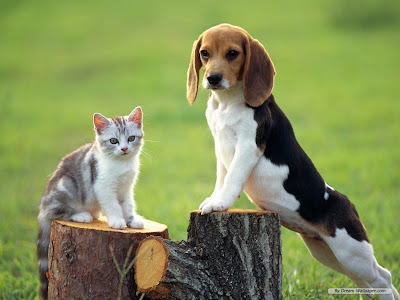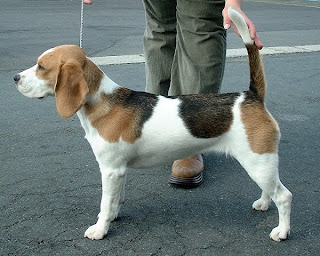The Beagle is a breed of dog that belongs to the group of dogs known as the hounds. A hound is a dog that is predominantly used for hunting. The purpose of the Beagle was originally to hunt small game such as Hare or Rabbit. In modern times, the Beagle has become a versatile dog whose work includes services to quarantine, termite detection, companion dog, pet therapy, and use in movies and commercials. However, its most valuable asset in being an ideal family pet is what makes Beagles one of the most popular and sought after breeds of hound. They are an attractive, relatively low maintenance dog but being a pack dog, require a lot of attention and regular company.
Whilst the height of a Beagle varies across the world, it is generally accepted that a Beagle should be between thirteen inches (33cm) and sixteen inches (40cm) when measured to the Beagle’s withers (the top of their shoulders). There are many different colour variations of the Beagle, from the traditional tricolour (black back blending into tan and white), to Tan and White, Lemon and White, mottles and pieds. Regardless of the colour combination, all Beagles will have a white tip on their tail, known as their “Stern or Flag”. This has been bred into the breed so that when the Beagle is out in the grass hunting, they have their nose down and their tail in the air, with their white tip being easily seen by their owners. The Beagle has the characteristic of being a devoted family member that will provide many hours of fun, love and amusement each day.
 |
| Beagle |
General Health
The Beagle is a breed that is not susceptible to many of the canine characteristics that can be found in other breeds of dogs. They are not prone to hip displacement, back problems, breathing difficulties or other conditions that can be found in other breeds. Generally, the Beagle breed is very sound. Their proportions and size reduce their susceptibility to structural problems. Unfortunately, this, along with their placid nature, may be the reason why some countries use Beagles for experiments and testing of products. All mammals, including dogs, are equally susceptible to the regular conditions and diseases that mammals can get. Beagles are no exception. There is the same percentage of Beagles with epilepsy, for example, as you will find in any breed of dog or any species of mammal.
History Beagle
It is always useful to know about the history of any breed of dog, as this provides valuable insight into the likely nature of the breed. Beagles have a long and consistent history and, as a result, have a lot of natural instinct. As a breed, Beagles have been in existence for quite some time, although their precise origins are only vaguely known. Beagle type dogs are described in documents dating from 400BC Greece and 200AD Britain. The Romans are also thought to have transported to England with them small rabbit hunting hounds and bred them with the local hounds. Talbot Hounds were brought to England from France during the Norman Conquest in 1066 and are considered to be ancestors to the Southern Hound, the Beagle and the Foxhound. Beagles became popular with the British monarchy in the 1300 and 1400s. Edward II and Henry VII both kept packs of Glove Beagles, so named since they were small enough to fit on a glove.
By the 1400s Beagles existed in Britain, Italy, Greece and France. The word “Beagle” has two possible origins. It either originated from the word “beag” which means small or from the French word “begle” meaning “useless or of little value”. By the 1700s two types of hounds existed for hunting rabbits: the Southern Hound and the much quicker North Country Beagle. Since fox hunting was becoming increasingly popular, Beagles were being kept less and less in favour of Foxhounds. Fortunately for the continuing existence of the Beagle, farmers in England, Ireland and Wales continued to keep packs to hunt with. Traditionally, it was said that the rich man kept a pack of foxhounds and hunted on horseback where the horses could keep up with the foxhounds in pursuit. The poorer man kept packs of Beagles, because they had fewer horses and pursued the packs of Beagles on foot. In the mid 1800s Reverend Phillip Honeywood established his pack of Beagles in Essex, England, which is thought to be the progenitor of the modern Beagle. He was breeding for hunting skills though, not for looks. A fellow Englishman, Thomas Johnson, was responsible for breeding lines of Beagles that could hunt and look attractive.
 |
| Beagle Dog |
The Beagle’s gentle, playful nature soon makes most children comfortable. As the Beagle has the temperament well suited to children, it is also important for children to learn to respect the Beagle’s needs and to value the Beagle as being part of their family. Whilst the Beagle is not a big dog, it is a breed that has stamina and will play with children for as long as the kids can keep up. Quite often it is the children that tire before the Beagle. Most people who have had Beagles know that their reputation as “the eternal puppy” is well earned. The Beagle remains playful for most of their lives and it is not uncommon to see thirteen or fourteen-year-old Beagles wanting to play with the same enthusiasm they had when they were a puppy. You need to keep this in mind when considering a Beagle, as they will need companionship and attention their whole lives.
 |
| Beagle |
Feeding Beagle
There are many different brands of high quality dry food available, which provide a complete balanced diet for your Beagle from puppy stage to senior citizen and require no additional supplements. These dry foods are mainly available from your veterinarian or produce store. Follow the recommended quantities for feeding your pet that are displayed on the packaging. If you do not want to feed your Beagle solely dry food, a combination of half dry food/half wet food is an alternative. Tinned dog food, meat rolls, dog casseroles etc, which are obtainable from the supermarket, are all suitable. Even a small tin of sardines or lean meat cuts mixed in with the dry food will be very welcomed by your Beagle.
Dogs of all descriptions need to eat bones for healthy teeth and gums. Give your Beagle a small brisket bone or dental biscuit at least every second day. A nice bone will also help to keep your beagle occupied while you are out of the house. As a change from a brisket bone you can also feed your beagle raw chicken necks or wings but NEVER feed any dog cooked bones as the composition of the bone is changed when cooked and can splinter and seriously injure your pet. Avoid feeding your Beagle spicy or fatty foods. Chocolate should be avoided at all times, as it is toxic to dogs. If you want to give your Beagle a small reward, there are many commercial products that are available from the supermarket. However, these dog treats should only be used occasionally and as a reward for good behaviour. Remember that Beagles love their food and will eat even if they don't need it, so just be wary of those sad Beagle eyes begging for more food do not overfeed your Beagle!!















0 comments:
Post a Comment